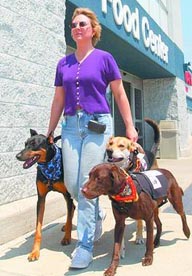Dog Once Mercilessly Abused Devotes Life to Serving Humans
www.delmarvanow.com
July 5, 2006, SALISBURY, MARYLAND - Kayne is not what you would call a pretty dog. His tail is gone -- cut off by a previous owner -- and his ears have been butchered, to put it nicely. His teeth are worn down and his paws are scarred. Those are the visible wounds. When the Doberman was discovered in a back yard two years ago, chained and left to die by owners who had moved away, few people thought he would survive.

But Kayne had quite a few guardian angels: the neighbor who discovered him, the veterinarian who treated his severe internal infections and the woman who took him home and nursed him back to health. He isn't pretty. But he's alive.
"People always say 'Ooooh, will he bite?'" said Mary Stadelbacher. "He's such a sweetheart."
Kayne is now trotting through Wal- Mart, obediently following Stadelbacher's every command. Barely through the front door, he considers sniffing at a young woman who reaches out to pet him. A sharp word from Stadelbacher changes his mind. Kayne is a service dog, she explains. Never mind the large "DO NOT PET-- Mobility Service Dog in Training" printed on Kayne's jacket. Everyone is curious.
"I have to remind him that he's not allowed to go and say hello," Stadelbacher said. For a dog, that's one tough assignment.
Stadelbacher is the founder of Shore Service Dogs, a non-profit organization which trains stray and abandoned animals to assist people with disabilities. "Most people know seeing-eye dogs, or seizure dogs, but dogs can also help with Alzheimer's patients, wheelchair patients, people who need help with balance." Kayne will eventually go to a disabled veteran. "There are a lot of guys and women coming back with life-and-limb- altering injuries," said Stadelbacher. "A dog doesn't replace what you've lost, but can make life easier if you don't have to ask for help with everything."
First, Kayne must complete his training, usually about two years of intense study. "It took a month for Kayne to realize he could play with other dogs without being attacked; that was all he knew." With the help of a mentor dog, Kayne learned how to play, walk on a leash and obey basic commands. He was introduced to medical equipment and taught to tune out strange sounds and distractions. He even had to learn to ignore people food -- not easy for an animal that spent part of its life starving. "That's the training they get for restaurants," explained Stadelbacher. "You don't want them to become vacuum cleaners."
Kayne's resume now includes pulling wheelchairs, closing car doors, opening cabinets and retrieving items from the floor or somewhere else in a room. He can assist with heavy objects, and help a disabled person up from a chair. Later, he'll learn to work solely with the person he's trained to assist. "My No. 1 goal," said Stadelbacher, "is that they (the service dogs) are safe around everyone."
Stadelbacher hopes a few humans can find it in their hearts to help the dogs. She needs volunteers to organize events, help with fund-raisers, write grants and do public relations for Shore Service Dogs. A Girl Scout troop is holding a car wash July 8 to raise money for Kayne. Stadelbacher will be there at 1:30 p.m. with all of her dogs to give a demonstration.
Eventually, Kayne will leave to do what he was trained to do. It's a bittersweet moment Stadelbacher both anticipates and dreads. "But hearing how they make such a difference, I can let them go."
